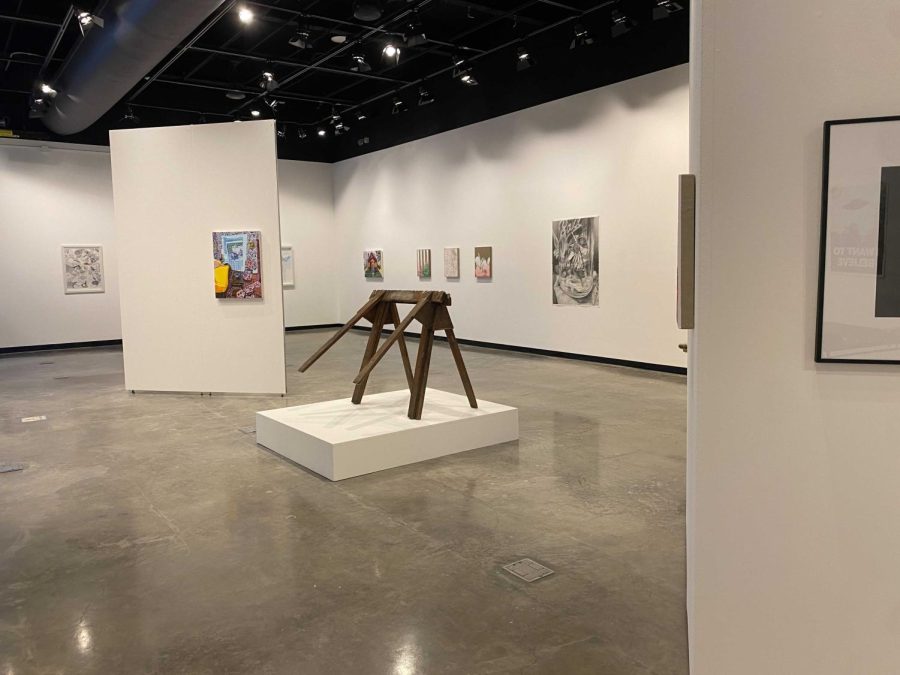DeVos Art Museums opens Still Life exhibit
STILL LIFE—As a reflection on time spent during the pandemic, the DeVos Art Museum at NMU will hold the Still Life exhibition until March 22.
January 25, 2022
The DeVos Art Museum opened a Still Life exhibit on Friday, Jan. 21 that uses art as a way to reflect on the time spent in the COVID-19 pandemic.
The DeVos Art Museum, inside NMU’s Art and Design building, currently features still life art from 13 contemporary artists including graphite drawings, art made entirely of carved wood, collages made of paint samples and photographs among many other mediums.
What brings these pieces together is how they showcase what the still life genre means in today’s modern era, said Emily Lanctot, director of the DeVos Art Museum.
“[The exhibit] is about how we have had to be still – where we have had to observe others’ things through screens or observe each other from behind a mask,” Lanctot said. “Art has this way of explaining the world to us that can be really powerful.”
This genre of art can often be seen as something of the past but is still important today especially in terms of the pandemic, said James Asava, a junior art and design major with experience in still life photography.
“Still life is still very relevant today because it can be shown in many different ways from painting to drawing to photography,” said Asava. “Speaking of the pandemic, this type of art can speak to experiences others have not experienced.”
Melissa Cooke Benson, a graphite pencil artist based in Minneapolis, has six pieces featured at the exhibit all of which showcasing her experiences of the pandemic.
“Still life became a way to reflect on where you’re at and where the world is at,” Benson said. “I think a lot of artists have turned to drawing their interior spaces or various objects as a way of partially reflecting and partially because it was all that was available to some.”
Benson reflects on her own environment in a drawing that sits on the back wall of the exhibition showing a butterfly enclosed in a jar that she caught as a caterpillar with her daughter.
“It became metaphoric – where it’s this beautiful thing but it’s slightly in captivity,” Benson said. “Where I was also feeling a bit stuck inside or captive inside our own house, but it became this symbol of hope, and growth, a symbol of change.”
Lanctot came up with the idea for this exhibition over the summer to evaluate this relationship of the everydayness of life during the pandemic.
“I was thinking a lot about the still life genre and how it speaks to transience and the everyday,” Lanctot said. “I wanted to work on an exhibition that would be a contemporary spin on that.”
The Still Life exhibition starts off with drawings of skeletal remains buried in ice drawn by Alaskan artist, Don Decker, that evaluates the relationship humans have with the natural environment, said Lanctot.
“I thought of his work as a beautiful way to examine the beauty of the environment, but also the chaos that we’ve launched into it,” Lanctot said. “This change is happening incrementally and yet really rapidly.”
The exhibition is wrapped up with an acrylic painting of an off-centered chair positioned at a vanity by New York painter, Gabrielle Garland, that focuses on the passage and perception of time, said Lanctot.
“The end of the show is speaking to the dwindling of time and understanding that it is finite through this candle and the vanity,” Lanctot said. “The space is almost dizzying in that here we are in the interior, and within this space there’s a lot of fragmentation.”
The Still Life exhibition at the DeVos Art Museum can be visited Monday through Friday from 12 p.m. to 5 p.m. until March 22 and is both free and open to the public.
“Everyone should go to the museum because it has passion and emotion, and artists pour their hearts out for people to see it,” Asava said.



























